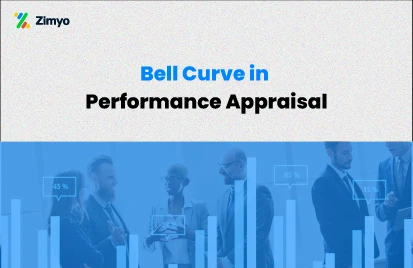“Performance management is not just a tick-the-box activity; it’s a strategic imperative for success.”
In today’s rapidly evolving workplace, effective performance management is more crucial than ever. But what exactly are the objectives of performance management? It goes far beyond the traditional annual evaluations and appraisals. It’s about promoting a culture of continuous improvement. It helps in aligning individual goals with the broader organizational objectives.
Are you wondering why this matters so much? For managers, HR professionals, and decision-makers, understanding these objectives is important to find your team’s full potential. Performance management is the driving force of organizational success.
In this blog, we will explore the objectives of performance management in detail, along with its definition, importance, and the key differences between performance management and performance appraisal.

What is Performance Management?
Before going into the objectives of performance management, let’s first understand what performance management actually means. At its core, performance management is more than just an annual review. It’s a sort of 360-degree approach that covers planning, monitoring, developing, and evaluating employee performance. But why is this important?
Performance Management Definition:
Performance management is an ongoing process where managers and employees work together to plan, monitor, and review an employee’s work objectives and overall contribution to the organization.
It is a continuous process aimed at improving organizational performance by enhancing individual performance through regular feedback, coaching, and performance evaluation.
How It's Different from Performance Appraisal:
While the two terms are often used interchangeably, they’re not the same.
Aspect | Performance Management | Performance Appraisal |
Focus | Ongoing process | Annual or periodic review |
Objective | Development, alignment, engagement | Evaluation of past performance |
Feedback | Continuous | Once or twice a year |
Scope | Broader (includes goal setting, training) | Narrower (mostly review and rating) |
Importance of Performance Management
A well-structured performance management system is essential for organizational success. Here’s why it matters:
- Enhances Productivity: Clear goals and regular feedback improve focus and efficiency.
- Boosts Employee Morale: Employees feel valued when their efforts are recognized.
- Reduces Turnover: Satisfied and engaged employees are less likely to leave.
- Encourages Accountability: Employees understand their responsibilities and how their work impacts the company.
- Helps Make Informed HR Decisions: Data from PMS helps with promotions, compensations, and terminations.
Why Use Performance Management Software?
Have you considered how much easier it is to manage performance with the right tools? A good performance management software automates the process. It provides real-time data. This way it allows managers to give timely feedback and make informed decisions.
But that’s not all. The aim of performance management is also to reduce biases in appraisals. How does performance management software help? By offering objective criteria, consistent evaluation methods, and comprehensive reporting tools, your HRM system ensures fairness across the board.
Performance Management Objectives
The main goal of performance management is to ensure that the workforce performs to the best of their abilities and contributes to organizational goals. Below are the key objectives. Let’s explore these objectives in more detail.
1. Setting Clear Goals
First and foremost, the goal of performance management is to establish clear, measurable objectives. But why is this so crucial? Because clear goals provide direction and purpose, both for individuals and the organization as a whole. Here’s how you can ensure your performance management objectives are on point:
- Be Specific: Vague goals lead to vague results. For instance, instead of saying “increase sales,” set a target like “increase sales revenue by 30% within the next quarter.”
- Ensure Alignment: The aim of performance management is to connect individual goals with the company’s broader strategy.
- Follow SMART Criteria: Use the SMART framework—Specific, Measurable, Achievable, Relevant, and Time-bound. This ensures clarity and accountability.
- Review Regularly: Goals should evolve with changing circumstances. Are you regularly reviewing and adjusting them as needed? An efficient performance management software can help with that.
2. Open Communication
Effective communication is the backbone of any successful organization. The aim of performance management is to create channels for regular feedback and open dialogue between managers and employees. Here are some ways to enhance communication in your performance management strategy:
- Regular Check-ins: Schedule one-on-one meetings to discuss progress, address concerns, and provide feedback.
- Encourage Open Dialogue: Promote a culture where employees feel comfortable sharing their ideas and challenges.
- Use Technology: Use performance management software and other tools so that your employees can communicate openly. Whether it’s project management or collaboration platforms, technology can make information sharing easier.
- Provide Training: Equip your managers with the skills they need for effective communication. Are they trained in active listening and giving constructive feedback?
3. Ensuring Fair & Transparent Evaluation
Fairness and transparency are non-negotiable when it comes to performance evaluations. The goal of performance management is to create a fair and objective system for assessing employee performance. Consider these strategies:
- Clear Evaluation Criteria: Communicate the criteria for assessments clearly. Are your employees aware of what’s expected?
- Training for Evaluators: Ensure that managers are trained to conduct unbiased assessments. Is your performance management software equipped to track this?
- Self-Evaluations: Encourage employees to assess their own performance. How does this fit into your overall performance management strategy?
4. Facilitating Employee Development
Performance management isn’t just about looking back—it’s about planning for the future. The aim of performance management is to make sure that employees have all the necessary resources they need to grow. Here’s how you can support employee development:
- Regular Skill Assessments: Identify existing skills and areas for improvement. Are you doing this consistently?
- Customized Training Opportunities: Offer training that aligns with individual career goals. We suggest you utilize an effective performance management software to track these opportunities.
- Individual Development Plans: Collaborate with employees to create development plans. Integrate these plans into your HRMS.
5. Seeking Continuous Feedback
Continuous feedback is important for growth and development. But how do you ensure that it’s happening regularly? The goal of performance management is to create a culture where feedback is ongoing, not just an annual event. Here’s how you can make continuous feedback a reality:
- Regularly Scheduled Check-Ins: Set up a consistent schedule for one-on-one meetings. A proficient performance management software can help you maintain this routine.
- Balanced Feedback: Provide a mix of positive and constructive feedback. Try to balance these in your conversations with the employees.
- Doing Self-Reflection: Encourage employees to reflect on their performance. Tell them to come prepared with insights and questions during feedback sessions.
Scope of Performance Management
Performance management touches every aspect of human resource development and strategy. Its scope includes:
- Goal Setting: Helps define clear, measurable, and achievable goals.
- Performance Monitoring: Tracks progress against the set goals in real time.
- Performance Reviews: Provides a formal evaluation of employee performance.
- Training & Development: Identifies learning needs and facilitates professional growth.
- Rewards & Recognition: Ensures that contributions are appreciated and rewarded.
- Feedback Mechanism: Creates a two-way communication channel between employee and manager.
- Career Planning: Aligns individual aspirations with business goals.
Real-Life Relevance: PMS & NPS Fund Managers
In sectors like financial services, performance management is extremely critical. For example, NPS fund managers (National Pension Scheme fund managers) are regularly evaluated using a performance management system. Their portfolio returns, risk management, and compliance standards are monitored continuously to ensure the best outcomes for investors.
Conclusion
Understanding the objectives of performance management is essential for any business aiming to grow sustainably. It’s not just about reviewing performance but enabling continuous development, goal alignment, and employee engagement.
A strong performance management system (PMS) helps drive success at every level, from individual employees to the entire organization. Whether you’re an HR professional or a team leader, investing in performance management is key to building a motivated and productive workforce.
Zimyo Performance Management Software
Ready to upgrade your performance management strategy? With Zimyo, the best performance management software out there, you can easily align your team’s goals, carry out open communication, and ensure fair evaluations—all in one platform. Help your organization reach success by creating a culture of continuous improvement and growth. Don’t wait—take the first step towards a smarter, more efficient performance management process today.
FAQs:
What is performance management in simple terms?
Performance management is a continuous process that helps organizations align employee performance with business goals through planning, monitoring, and feedback.
What are the main objectives of performance management?
The primary objectives are to improve productivity, align employee efforts with organizational goals, provide feedback, support development, and recognize performance.
How is performance management different from performance appraisal?
Performance management is a continuous, strategic process involving feedback and development. Performance appraisal is a periodic evaluation of past performance, usually done annually. dipiscing elit. Ut elit tellus, luctus nec ullamcorper mattis, pulvinar dapibus leo.
What does a performance management system (PMS) include?
A PMS includes goal setting, monitoring, reviews, training, feedback, rewards, and career planning mechanisms.
Why is performance management important?
It boosts productivity, improves employee engagement, supports career growth, and helps organizations achieve strategic goals.
How do NPS fund managers use performance management?
NPS fund managers are assessed using PMS to ensure their investment strategies deliver consistent and compliant results to beneficiaries.







